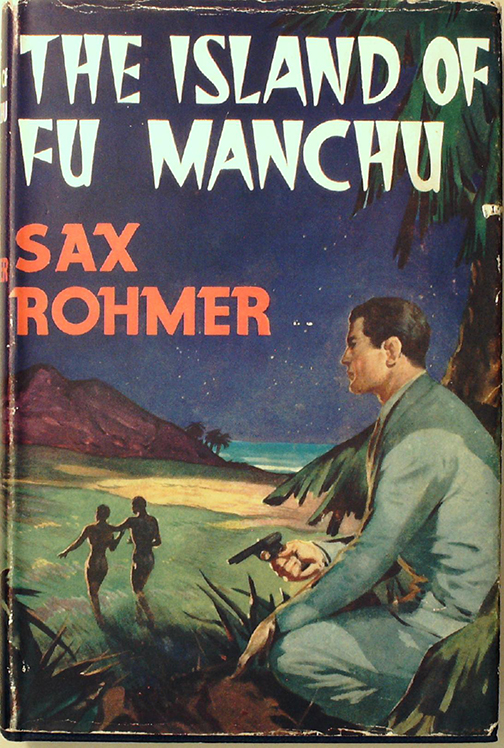 This post is part of an ongoing series featuring items recently cataloged from the Julio Mario Santo Domingo Collection.
This post is part of an ongoing series featuring items recently cataloged from the Julio Mario Santo Domingo Collection.
Among recently-cataloged volumes in the Santo Domingo Collection is this small gathering of works by Sax Rohmer (1883-1959), an English novelist whose signal creation is the villainous crime lord Dr. Fu Manchu. Born Arthur Henry Ward, Rohmer published a handful of short stories before the first Fu Manchu book, The Mystery of Dr. Fu-Manchu, catapulted him to literary success in 1913. He would ultimately write thirteen Fu Manchu books, which were variously adapted into film, radio, television, and comics, assuring the character’s status in the halls of fictional villainry.

The early novels revolve around the malevolent doctor’s bids for world domination, and the efforts of Dennis Nayland Smith and Dr. Petrie, a pair of investigators analogous to Holmes and Watson, to oppose him; which efforts always fall short of his capture. Fu Manchu has at his disposal a vast and secretive network of informants and assassins, arcane knowledge of poison and other biological weaponry (including gigantic spiders, lizards, and Venus fly traps), and, in later stories, access to an elixir of immortality. One of his hideouts is in London’s Limehouse district, a neighborhood that had seen an influx of Chinese immigrants beginning in the early nineteenth century, and which had taken hold in the popular English imagination as a place of vice and criminality, riddled with opium dens. (Charles Dickens’s final, unfinished novel, The mystery of Edwin Drood, concerns the secret life of an opium-addicted visitor to Limehouse.)

This perception of the Chinese was part of a decades-old racial anxiety throughout Europe and the United States, sometimes called “the Yellow Peril” or “the Yellow Terror”. This tide of xenophobic sentiment turned on the belief that East Asians – a horde not differentiated by individual, cultural, or even national identity – presented a threat to the western world, ranging from taking away working-class jobs to total conquest. Rohmer did not invent these prejudices, but he capitalized on them in creating Fu Manchu, whom he describes in The Insidious Dr. Fu Manchu as “the yellow peril incarnate in one man”: cunning, malevolent, and endowed with strange powers, with a numberless army to do his bidding. The stories themselves escalate the threat of the Yellow Peril to a global conspiracy spun from Fu Manchu’s formidable intelligence and resources.

Rohmer was author of a great many novels and stories – some featured Sumuru, a female archvillain in the Fu Manchu mold; some were traditional detective and crime fiction; some tended toward occult horror – but none so enduring as Fu Manchu. The cover images pictured here are from the Cassell “cheap editions”, printed in the mid-1950s. On two of them we see the title character wearing his eponymous long mustache and goatee, another of his lasting cultural emblems. This facial hair was not, in fact, Rohmer’s invention, but is an artifact of the film versions of the character: Dennis Nayland Smith explicitly describes Fu Manchu’s “wicked, hairless face” in The insidious Dr. Fu Manchu.
The bride of Fu Manchu: EC9.R6365.933be
The island of Fu Manchu: EC9.R6365.941ib
President Fu Manchu: EC9.R6365.936pb
The trail of Fu Manchu: EC9.R6365.934tb
Thanks to rare book cataloger Ryan Wheeler for contributing this post.
